Responses of Stream Geomorphic Indices to Piedmont Fault Activity in the Northern Segment of the Red River Fault Zone
Abstract
:1. Introduction
2. Regional Geological Overview
3. Data and Methods
3.1. Slope and Relief Degree of the Land Surface (RDLS)
3.2. Hypsometric Integral (HI)
3.3. Channel Steepness Index (ksn)
4. Results
4.1. Slope and Relief Degree of the Land Surface (RDLS)
4.2. Hypsometric Integral (HI)
4.3. Channel Steepness Index (ksn)
4.4. Indication of Stream Geomorphic Index to Active Tectonics
5. Discussion
5.1. Lithology and Climatic Factors
5.2. Tectonics
6. Conclusions
- (1)
- The comprehensive analysis of multiple indices shows that the degree of activity along the northern segment of the Red River Fault Zone is relatively high, indicating that the future strong earthquake risk of the northern segment is worthy of attention.
- (2)
- The difference of tectonic activity intensity in the northern segment of the Red River Fault Zone is the main factor affecting the river landform change. The activity of the Cangshan Piedmont Fault is the highest. The spatial difference in geomorphic index values reflects the trend of decreasing activity in the northern segment from north to south, which is consistent with the trend of decreasing activity in the Red River Fault Zone from the northern segment to the middle and southern segments.
- (3)
- Among the factors of climate, lithology and tectonics, neotectonics are the main factor controlling the fluvial geomorphology development of each secondary fault in the northern segment of the Red River Fault Zone. The relative strength of tectonic activity in the northern segment of the Red River Fault Zone obtained by fluvial geomorphology is consistent with the findings of previous studies, indicating that drainage basins can effectively reflect regional differences in tectonic activity.
Author Contributions
Funding
Data Availability Statement
Acknowledgments
Conflicts of Interest
References
- Royden, L.H.; Burchfiel, B.C.; King, R.W.; Wang, E.; Chen, Z.; Shen, F.; Liu, Y. Surface deformation and lower crustal flow in eastern Tibet. Science 1997, 276, 788–790. [Google Scholar] [CrossRef]
- Royden, L.H.; Burchfiel, B.C.; van der Hilst, R.D. The geological evolution of the Tibetan Plateau. Science 2008, 321, 1054–1058. [Google Scholar] [CrossRef]
- Clark, M.K.; Royden, L.H. Topographic ooze: Building the eastern margin of Tibet by lower crustal flow. Geology 2000, 28, 703–706. [Google Scholar] [CrossRef]
- Shen, F.; Royden, L.H.; Burchfiel, B.C. Large-scale crustal deformation of the Tibetan Plateau. J. Geophys. Res. Solid Earth 2001, 106, 6793–6816. [Google Scholar] [CrossRef]
- Su, Y.J.; Qin, J.Z. Relationship between strong seismic activity and regional neotectonic movement in Sichuan-Yunnan Area. Earthq. Res. China 2001, 17, 24–34. [Google Scholar]
- Xu, X.X.; Ji, L.Y.; Zhu, L.Y.; Wang, G.M.; Zhang, W.T.; Li, N. The co-seismic defomation characteristics and seismogenic structure of the Yangbi M,6.4 earthquake. Seismol. Geol. 2021, 43, 771–789. [Google Scholar]
- Wan, Y.K.; Shen, X.Q.; Liu, R.F.; Liu, X.; Zheng, Z.J.; Li, Y.; Zhang, Y.; Wang, L. Present motion and stress distribution of active block boundary faults in Sichuan-Yunnan region. Seismol. Geol. 2021, 43, 1614. [Google Scholar]
- Molnar, P.; Tapponnier, P. Cenozoic tectonics of Asia: Effects of a continental collision. Science 1975, 189, 419–426. [Google Scholar] [CrossRef] [PubMed]
- Allen, C.R.; Gillespie, A.R.; Yuan, H.A.N.; Sieh, K.E.; Buchun, Z.; Chengnan, Z.H.U. Red River and associated faults, Yunnan Province, China: Quaternary geology, slip rates, and seismic hazard. GSA Bull. 1984, 95, 686–700. [Google Scholar] [CrossRef]
- Replumaz, A.; Lacassin, R.; Tapponnier, P.; Leloup, P.H. Large river offsets and Plio-Quaternary dextral slip rate on the Red River fault (Yunnan, China). J. Geophys. Res. Solid Earth 2001, 106, 819–836. [Google Scholar] [CrossRef]
- Liu, B.M.; Xia, B.; Li, X.X.; Zhang, M.Q.; Niu, B.H.; Zhong, L.F.; Jin, Q.H.; Ji, S.C. Southeast extension of Honghe fault zone and its tectonic evolution significance. Sci. China D Earth Sci. 2006, 36, 914–924. [Google Scholar]
- Cao, S.Y.; Liu, J.L.; Bernd, L.; Zhao, C.Q. New Zircon U-Pb geochronology of the post-kinematic granitic plutons in the Diancang Shan metamorphic massif along the Ailao Shan-Red River shear zone and its geological implications. Acta Geol. Sin. Engl. Ed. 2010, 84, 1474–1487. [Google Scholar] [CrossRef]
- Zuchiewicz, W.; Cu’ò’ng, N.Q.; Zasadni, J.; Yêm, N.T. Late Cenozoic tectonics of the Red River Fault Zone, Vietnam, in the light of geomorphic studies. J. Geodyn. 2013, 69, 11–30. [Google Scholar] [CrossRef]
- Fyhn, M.B.W.; Phach, P.V. Late Neogene structural inversion around the northern Gulf of Tonkin, Vietnam: Effects from right-lateral displacement across the Red River fault zone. Tectonics 2015, 34, 290–312. [Google Scholar] [CrossRef]
- Yu, N.; Unsworth, M.; Wang, X.B.; Li, D.W.; Wang, E.C.; Li, R.H.; Hu, Y.B.; Cai, X.L. New insights into crustal and mantle flow beneath the Red river fault zone and adjacent areas on the Southern margin of the Tibetan Plateau revealed by a 3-D magnetotelluric study. J. Geophys. Res. Solid Earth 2020, 125, e2020JB019396. [Google Scholar] [CrossRef]
- Wen, X.Z.; Ma, S.L.; Fang, L.H.; Liang, M.J.; Du, F.; Long, F.; Zhao, X. Complex structural fault system and distributed deformation across the Big Bend of the Red River fault, Yunnan, China. Phys. Earth Planet. Inter. 2022, 333, 106942. [Google Scholar] [CrossRef]
- Zhong, D.B.; Tapponnier, P.; Wu, H.W.; Zhang, L.S. Large strike-slip fault-an important form of intracontinental deformation after collision. Chin. Sci. Bull. 1989, 34, 526–529. [Google Scholar]
- Tapponnier, P.; Lacassin, R.; Leloup, P.H.; Schärer, U.; Dalai, Z.; Haiwei, W.; Xiaohan, L.; Shaocheng, J.; Lianshang, Z.; Jiayou, Z. The Ailao Shan/Red River metamorphic belt: Tertiary left-lateral shear between Indochina and South China. Nature 1990, 343, 431–437. [Google Scholar] [CrossRef]
- Leloup, P.H.; Lacassin, R.; Tapponnier, P.; Schärer, U.; Zhong, D.; Liu, X.; Zhang, L.; Ji, S.; Trinh, P.T. The Ailao Shan-Red River shear zone (Yunnan, China), tertiary transform boundary of Indochina. Tectonophysics 1995, 251, 3–84. [Google Scholar] [CrossRef]
- Roger, F.; Leloup, P.H.; Jolivet, M.; Lacassin, R.; Trinh, P.T.; Brunel, M.; Seward, D. Long and complex thermal history of the Song Chay metamorphic dome (Northern Vietnam) by multi-system geochronology. Tectonophysics 2000, 321, 449–466. [Google Scholar] [CrossRef]
- Zhou, Y.; Zhou, P.; Wu, S.M.; Shi, X.B.; Zhang, J.J. Magnetic fabric study across the Ailao Shan–Red River shear zone. Tectonophysics 2002, 346, 137–150. [Google Scholar] [CrossRef]
- Xiang, H.F.; Han, Z.J.; Guo, S.M.; Zhang, W.X.; Chen, L.C. Large-scale dextral strike-slip movement and associated tectonic geomorphology deformation in the Honghe fault zone. Seismol. Geol. 2004, 26, 597–610. [Google Scholar]
- Xiang, H.F.; Wan, J.L.; Han, Z.J.; Guo, S.M.; Zhang, W.X.; Chen, L.C.; Dong, X.Q. Geological analysis and FT dating of the occurrence time of large dextral strike-slip movement in the Honghe Fault zone. Sci. China D Earth Sci. 2006, 36, 977–987. [Google Scholar]
- Zhang, Q.Z.; Liu, Y.P.; Chen, Z.L.; Tang, W.Q.; Zhang, X.Y. GPS monitoring of the Red River Break. J. Earth Sci. 2006, 27, 367–372. [Google Scholar]
- Zhang, B.L.; Liu, R.X.; Xiang, H.F.; Chu, Q.Z.; Huang, X.N.; Zheng, Y.G. Fractal characteristics and rheological parameters of mylonite in the mid-southern section of Honghe fault zone. Seismol. Geol. 2008, 30, 473–483. [Google Scholar]
- Zhang, B.L.; Liu, R.X.; Xiang, H.F.; Wang, J.; Huang, X.N. Tectonic-rock characteristics and stress field evolution of fault activity in the mid-southern section of Honghe fault zone. J. Petrol. Mineral. 2008, 27, 529–537. [Google Scholar]
- Gilley, L.D.; Harrison, T.M.; Leloup, P.H.; Ryerson, F.J.; Lovera, O.M.; Wang, J.-H. Direct dating of left-lateral deformation along the Red River shear zone, China and Vietnam. J. Geophys. Res. Solid Earth 2003, 108, 2127. [Google Scholar] [CrossRef]
- Guo, S.M.; Li, X.Y.; Xiang, H.F. Kinematic Model and Modern Crustal Movement of the Tail Extension Area of the Honghe Strike-Slip Fault in Yunnan Province (5); Seismological Press: Beijing, China, 1991. [Google Scholar]
- Institute of Geology; China Earthquake Administrator; Yunnan Province Seismological Bureau. Active Faults in Northwest Yunnan; Seismological Press: Beijing, China, 1990.
- Guo, S.M.; Ji, F.J.; Xiang, H.F.; Dong, X.Q.; Yan, F.H.; Zhang, S.L.; Li, X.Y.; Zhang, W.X. Honghe Active Fault Zone Chinese Active Fault Research Album; Ocean Press: Beijing, China, 2001. [Google Scholar]
- Zhang, Q.Z.; Liu, Y.P.; Chen, Z.L.; Tang, W.Q. GPS data inversion of the Honghe fault zone. Prog. Geophys. 2007, 22, 48–421. [Google Scholar]
- Zhang, J.G. Study on the Fault Activity of Honghe River in Central Vietnam; University of Science and Technology of China: Hefei, China, 2009. [Google Scholar]
- Hack, J. Studies of Longitudinal Profiles in Virginia and Maryland: U.S. Geological Survey Professional Paper 294B; United States Government Printing Office: Washington, DC, USA, 1957.
- Whipple, K. Bedrock rivers and the geomorphology of active orogens. Annu. Rev. Earth Planet. Sci. 2004, 32, 151. [Google Scholar] [CrossRef]
- Kirby, E.; Whipple, K.X. Expression of active tectonics in erosional landscapes. J. Struct. Geol. 2012, 44, 54–75. [Google Scholar] [CrossRef]
- Schwanghart, W.; Kuhn, N.J. TopoToolbox: A set of Matlab functions for topographic analysis. Environ. Model. Softw. 2010, 25, 770–781. [Google Scholar] [CrossRef]
- Schwanghart, W.; Scherler, D. Short communication: TopoToolbox 2–MATLAB-based software for topographic analysis and modeling in Earth surface sciences. Earth Surf. Dynam. 2014, 2, 1–7. [Google Scholar] [CrossRef]
- Willett, S.D.; McCoy, S.W.; Perron, J.T.; Goren, L.; Chen, C.Y. Dynamic reorganization of river basins. Science 2014, 343, 1248765. [Google Scholar] [CrossRef]
- Dai, Y.; Wang, X.Y.; Wang, S.L.; Li, Y.Q.; Lu, H.Y. The neotectonic activity of Wanchuan River Basin in the northeastern Tibetan Plateau reflected by geomorphologic morphology index. Acta Geogr. Sin. 2016, 71, 412–421. [Google Scholar] [CrossRef]
- Xu, W.; Yuan, Z.D.; Liu, Z.C.; Gao, Z.W. Fluvial geomorphic parameters and their neotectonic significance at the northern foot of Zhongtiaoshan Mountains. Arid Land Geogr. 2018, 41, 1009–1017. [Google Scholar]
- Forte, A.; Whipple, K. Short communication: The Topographic Analysis Kit (TAK) for TopoToolbox. Earth Surf. Dyn. 2019, 7, 87–95. [Google Scholar] [CrossRef]
- Wang, J.Y.; He, Z.T. Responses of stream geomorphic indices to piedmont fault activity in the Daqingshan area of China. J. Earth Sci. 2020, 31, 978–987. [Google Scholar] [CrossRef]
- Defo, P.L.W.; Owona, S.; Nsangou Ngapna, M.; Balla Ateba, C.; Mwabanua Mutabi, C. Post-orogenic transients and relict landforms of the Bafoussam-Mamfe region (West-Cameroon Highland margin). J. Mt. Sci. 2022, 19, 2180–2201. [Google Scholar] [CrossRef]
- Ji, F.J.; Guo, S.M.; Xiang, H.F. Spatial-temporal evolution of quaternary activity of the Honghe Fault zone. Seismol. Geol. 1997, 19, 108–114. [Google Scholar]
- Schoenbohm, L.M.; Burchfiel, B.C.; Liangzhong, C.; Jiyun, Y. Miocene to present activity along the Red River fault, China, in the context of continental extrusion, upper-crustal rotation, and lower-crustal flow. GSA Bull. 2006, 118, 672–688. [Google Scholar] [CrossRef]
- Shi, X.H.; Sieh, K.; Weldon, R.; Zhu, C.N.; Han, Y.; Yang, J.W.; Robinson, S.W. Slip rate and rare large prehistoric earthquakes of the Red River fault, Southwestern China. Geochem. Geophys. Geosys. 2018, 19, 2014–2031. [Google Scholar] [CrossRef]
- Yin, F.L.; Jiang, C.S.; Han, L.B.; Zhang, H.; Zhang, B. Seismic hazard assessment for the Red River fault: Insight from Coulomb stress evolution. Chin. J. Geophys. 2018, 61, 183–198. [Google Scholar]
- Li, N.; Kang, S.; Zhu, L.Y. To study the current locking degree and seismic risk of the Honghe fault zone based on GPS data. J. Geod. Geodyn. 2019, 39, 700–705. [Google Scholar]
- Xiang, H.F.; Guo, S.M.; Zhang, W.X.; Han, Z.J. Quantitative study of large dextral dislocations in the southern segment of Honghe Fault Zone since Miocene. Seismol. Geol. 2007, 29, 52–68. [Google Scholar]
- Wang, J.; Shen, C.Y.; Sun, W.K.; Tan, H.B.; Hu, M.Z.; Liang, W.F.; Han, Y.F.; Zhang, X.L.; Wu, G.J.; Wang, Q.H. Study on present gravity change and deep crust deformation in the Northern and middle sections of the red river fault zone. Seismol. Egol. 2021, 43, 1537. [Google Scholar] [CrossRef]
- Guo, S.M.; Xiang, H.F.; Ji, F.J.; Zhang, W.X. Study on the relationship between Quaternary dextral strike-slip and caudal extension transformation in the Honghe Fault zone. Seismol. Geol. 1996, 4, 301–309. [Google Scholar]
- Trinh, P.T.; Liem, N.V.; Huong, N.V.; Vinh, H.Q.; Thom, B.V.; Thao, B.T.; Tan, M.T.; Hoang, N. Late Quaternary tectonics and seismotectonics along the Red River fault zone, North Vietnam. Earth-Sci. Rev. 2012, 114, 224–235. [Google Scholar] [CrossRef]
- Scherler, D.; Bookhagen, B.; Strecker, M.R. Tectonic control on 10Be-derived erosion rates in the Garhwal Himalaya, India. J. Geophys. Res. Earth Surf. 2014, 119, 83–105. [Google Scholar] [CrossRef]
- Schmidt, K.M.; Montgomery, D.R. Limits to relief. Science 1995, 270, 617–620. [Google Scholar] [CrossRef]
- Whipple, K.X.; Kirby, E.; Brocklehurst, S.H. Geomorphic limits to climate-induced increases in topographic relief. Nature 1999, 401, 39–43. [Google Scholar] [CrossRef]
- Ouimet, W.B.; Whipple, K.X.; Granger, D.E. Beyond threshold hillslopes: Channel adjustment to base-level fall in tectonically active mountain ranges. Geology 2009, 37, 579–582. [Google Scholar] [CrossRef]
- Whipple, K.X.; Tucker, G.E. Dynamics of the stream-power river incision model: Implications for height limits of mountain ranges, landscape response timescales, and research needs. J. Geophys. Res. Solid Earth 1999, 104, 17661–17674. [Google Scholar] [CrossRef]
- Liang, O.B.; Ren, J.J.; Lu, Y.W. Response of fluvial geomorphological characteristics to Huya fault zone activity in the Fujiang River Basin. Seismol. Geol. 2018, 40, 42. [Google Scholar]
- Liang, O.B. Fluvial Geomorphic Index and Its Tectonic Significance at the Eastern Foot of Helan Mountain; Institute of Crustal Stress, China Earthquake Administration: Beijing, China, 2019.
- Singh, O.; Sarangi, A.; Sharma, M.C. Hypsometric integral estimation methods and its relevance on erosion status of North-Western lesser Himalayan Watersheds. Water Resour. Manag. 2008, 22, 1545–1560. [Google Scholar] [CrossRef]
- Pérez-Peña, J.V.; Azañón, J.M.; Booth-Rea, G.; Azor, A.; Delgado, J. Differentiating geology and tectonics using a spatial autocorrelation technique for the hypsometric integral. J. Geophys. Res. Earth Surf. 2009, 114, F02018. [Google Scholar] [CrossRef]
- Davis, W.M. The geographical cycle. Geogr. J. 1899, 14, 481–504. [Google Scholar] [CrossRef]
- Strahler, A.N. Hypsometric (area-altitude) analysis of erosional topography. GSA Bull. 1952, 63, 1117–1142. [Google Scholar] [CrossRef]
- Xin, Z.B.; Xu, J.X.; Ma, Y.X. Hypsometric integral analysis and its sediment yield implications in the Loess Plateau. China J. Mt. Sci. 2008, 3, 335–363. [Google Scholar]
- Chen, Y.J.; Song, G.C.; Chen, Z.N. Model of river hydraulic erosion in disequilibrium mountains. Chin. Sci. Bull. 2006, 7, 865–869. [Google Scholar]
- Pike, R.J.; Wilson, S.E. Elevation-relief ratio, hypsometric integral, and geomorphic area-altitude analysis. GSA Bull. 1971, 82, 1079–1084. [Google Scholar] [CrossRef]
- Tinkler, K.J.; Wohl, E.E. Rivers Over Rock: Fluvial Processes in Bedrock Channels; American Geophysical Union: Washington, DC, USA, 1998. [Google Scholar]
- Whittaker, A.C. How do landscapes record tectonics and climate? Lithosphere 2012, 4, 160–164. [Google Scholar] [CrossRef]
- Lague, D. The stream power river incision model: Evidence, theory and beyond. Earth Surf. Process. Landf. 2014, 39, 38–61. [Google Scholar] [CrossRef]
- Snyder, N.P.; Whipple, K.X.; Tucker, G.E.; Merritts, D.J. Landscape response to tectonic forcing: Digital elevation model analysis of stream profiles in the Mendocino triple junction region, northern California. GSA Bull. 2000, 112, 1250–1263. [Google Scholar] [CrossRef]
- Kirby, E.; Whipple, K. Quantifying differential rock uplift rates via stream profi le analysis: Geology. Geology 2001, 29, 415–418. [Google Scholar] [CrossRef]
- Wobus, C.; Whipple, K.X.; Kirby, E.; Snyder, N.; Johnson, J.; Spyropolou, K.; Crosby, B.; Sheehan, D. Tectonics from topography: Procedures, promise, and pitfalls. In Tectonics, Climate, and Landscape Evolution; Willett, S.D., Hovius, N., Brandon, M.T., Fisher, D.M., Eds.; Geological Society of America: Boluder, CO, USA, 2006; Volume 398, pp. 55–74. [Google Scholar]
- Flint, J.J. Stream gradient as a function of order, magnitude, and discharge. J. Water Resour. Res. 1974, 10, 969–973. [Google Scholar] [CrossRef]
- Wang, W.B.; Chen, X.Z. Comparison of principal component analysis and factor analysis methods in multi-index comprehensive evaluation. J. Stat. Inf. Forum 2006, 5, 19–22. [Google Scholar]
- Zhang, J.G.; Xie, Y.Q.; Jin, M.P. Study on the Activity of Honghe Fault in Central Vietnam; Yunnan Science and Technology Press: Kunming, China, 2009. [Google Scholar]
- Wang, S.J.; Zhang, J.G.; Yu, Q.K.; Long, X.F. Focal mechanism and modern tectonic stress field of Honghe fault zone. Geoseismic. Res. 2010, 3, 200–207. [Google Scholar]
- Yan, H.H.; Qiao, X.J.; Nie, Z.S.; Wang, W.; Zhao, B. The characteristics of crustal deformation and fault movement in the Honghe fault zone were studied by GPS. J. Geomat. 2019, 44, 36–40. [Google Scholar]
- Sun, G.H.; Peng, X.C.; Huang, Y.J. Geological structure characteristics of Yingge Sea Member of Honghe Fault zone. Acta Geol. Sinica 2013, 87, 154–166. [Google Scholar]
- Sun, Y.M.; Li, J.P. Current slip rate and strain accumulation in different tectonic segments of the Honghe fault zone. J. Trop. Oceanogr. 2018, 37, 89–96. [Google Scholar]
- Lu, X.F.; Tan, K.; Li, Q.; Li, C.T.; Wang, D.Z.; Zhang, C.H. Analysis of the current activity of the Red River fault based on GPS data: New seismological inferences. J. Seismol. 2021, 25, 1525–1535. [Google Scholar] [CrossRef]
- Wang, J.Y.; Xu, C.J.; Wen, Y.M.; Zang, J.F.; Xiao, Z.H. Characteristics of segmentation and interseismic coupling along the Red River fault from GPS observations. Chin. J. Geophys. 2022, 65, 1240–1254. [Google Scholar]
- Ding, G. Cluster and migration of fault activity on Quaternary faults. Quat. Sci. 1989, 1, 36–47. [Google Scholar]
- Huangfu, G.; Shi, S.X.; Su, Y.J. Study on seismic activity in Yunnan in the 20th century. Seismol. Res. 2000, 23, 1–9. [Google Scholar]
- Huangfu, G.; Qin, J.Z. Study on the regularity of large earthquakes in Yunnan Province. Seismol. Geol. 2006, 28, 37. [Google Scholar]
- Jiang, W.L.; Zhang, J.F.; Tian, T.; Wang, X. Crustal structure of Chuan-Dian region derived from gravity data and its tectonic implications. Phys. Earth Planet. Inter. 2012, 212–213, 76–87. [Google Scholar] [CrossRef]
- Chang, Z.F.; Zhang, Y.F.; Li, J.L.; Zang, Y. Geological and geomorphic manifestations of late Quaternary activity in Deqin-Zhongdian-Daju Fault. Seismol. Res. 2014, 37, 46–52. [Google Scholar]
- Chang, Z.F.; Chang, H.; Zang, Y.; Dai, B.Y. New activity characteristics of Weixi-Qiaohou fault and its relationship with Honghe fault. Chin. J. Geomech. 2016, 22, 517–530. [Google Scholar]
- Gao, Y.; Shi, Y.T.; Wang, Q. Seismic anisotropy in the southeastern margin of the Tibetan Plateau and its implications for deep tectonics. Chin. J. Geophys. 2020, 63, 802–816. [Google Scholar]
- Zhang, P.Z. Kinematics of present tectonic deformation in and around the Qinghai-Tibet Plateau. Seismol. Geol. 2004, 26, 367–376. [Google Scholar]
- Xu, X.W.; Wen, X.Z. Newly modified and changing patterns of active blocks in Sichuan-Yunnan region and their dynamic sources. Sci. China D 2003, 33, 151–162. [Google Scholar]
- Zhang, J.G.; Huangfu, G.; Xie, Y.Q. Investigation and research of Honghe fault zone in Zhongyue (I). J. Seismol. Res. 2008, 31, 362–368. [Google Scholar]
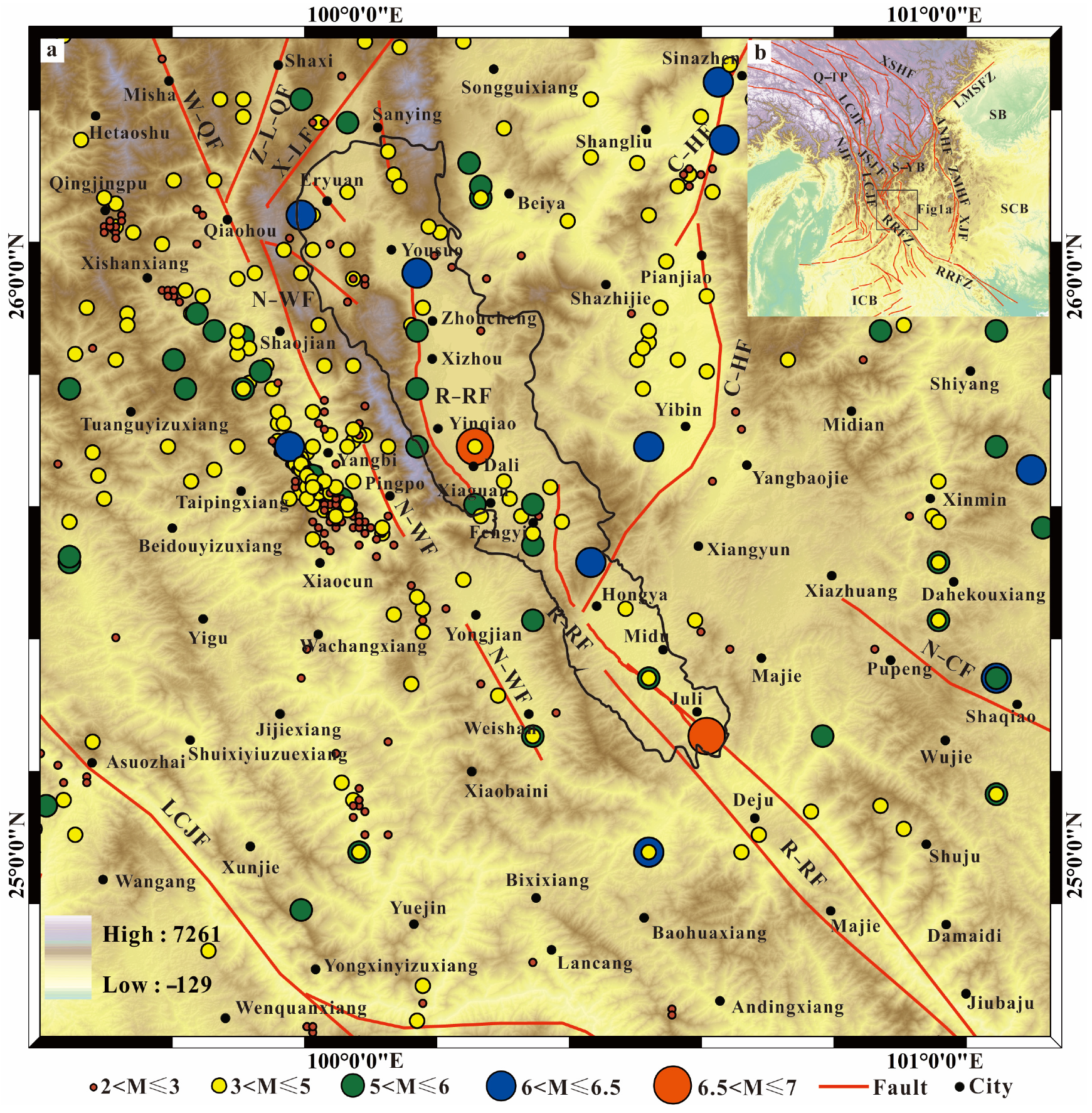


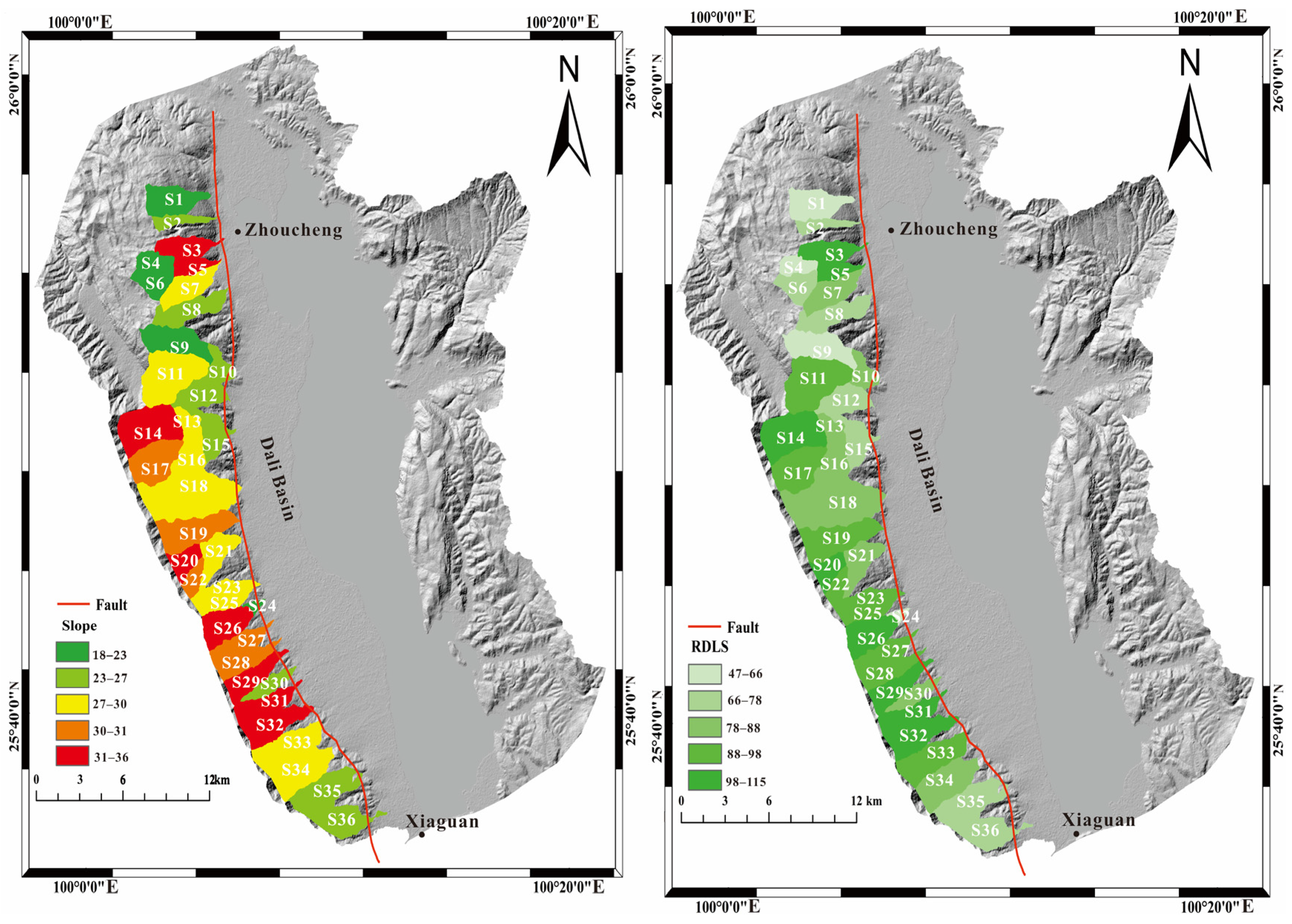
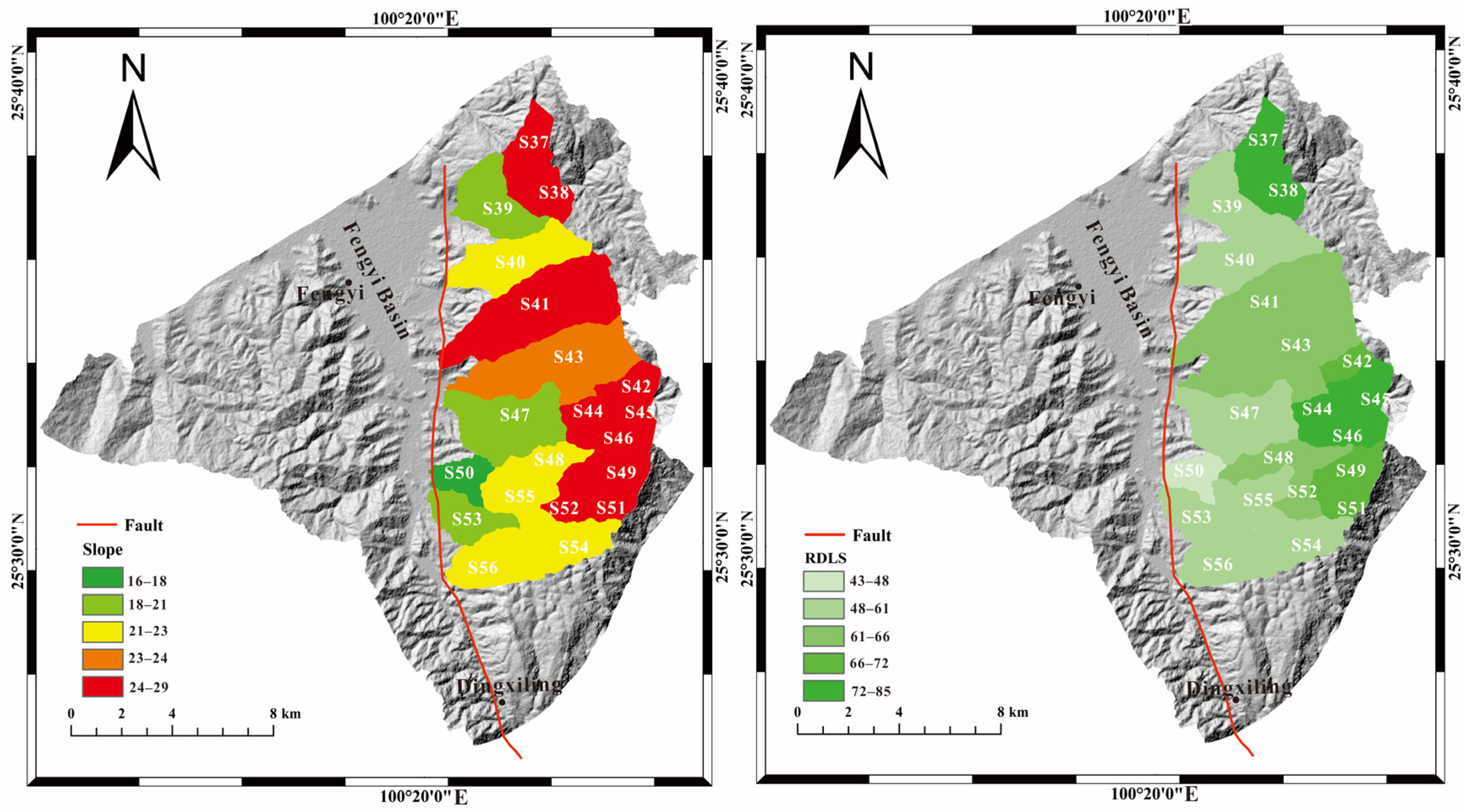
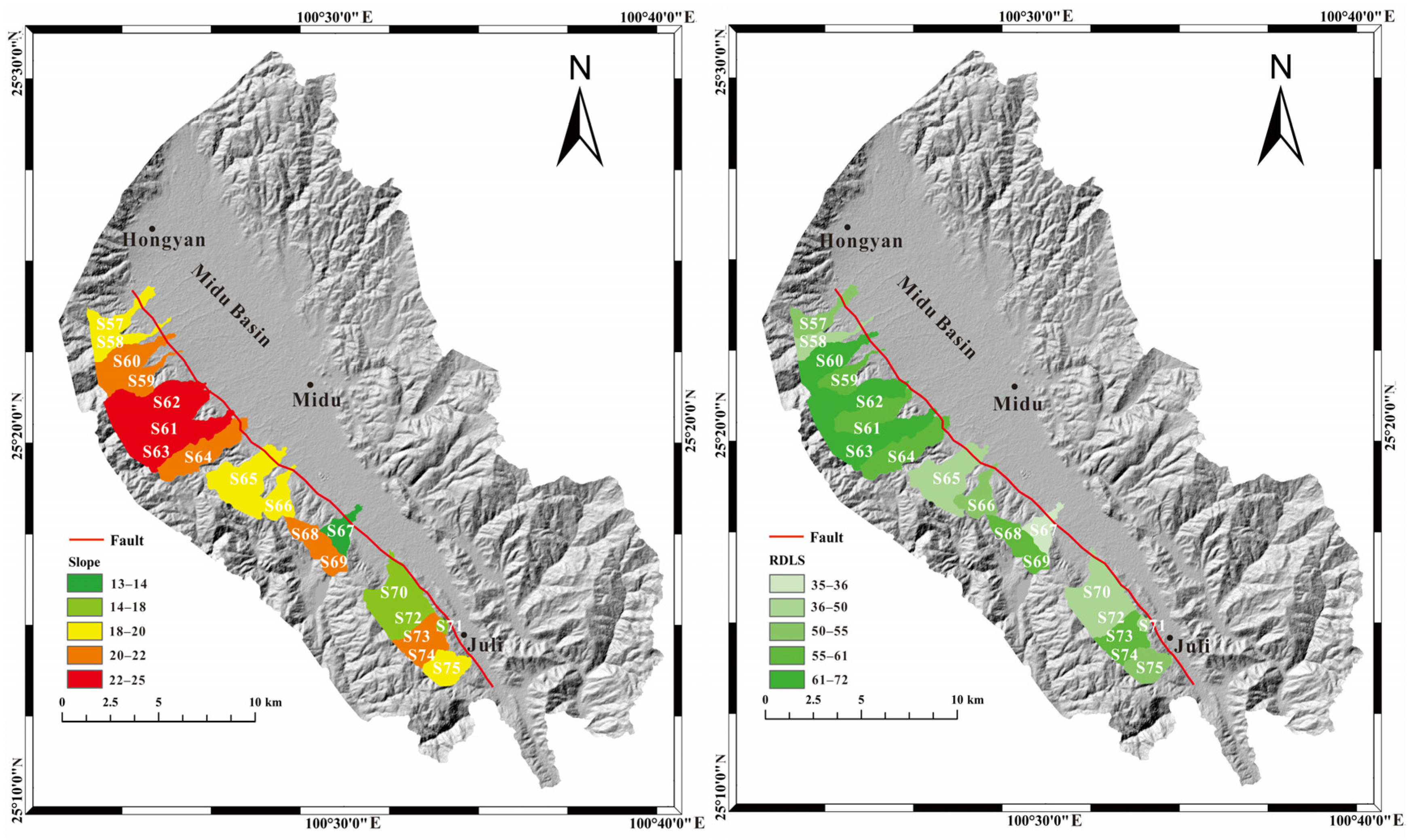
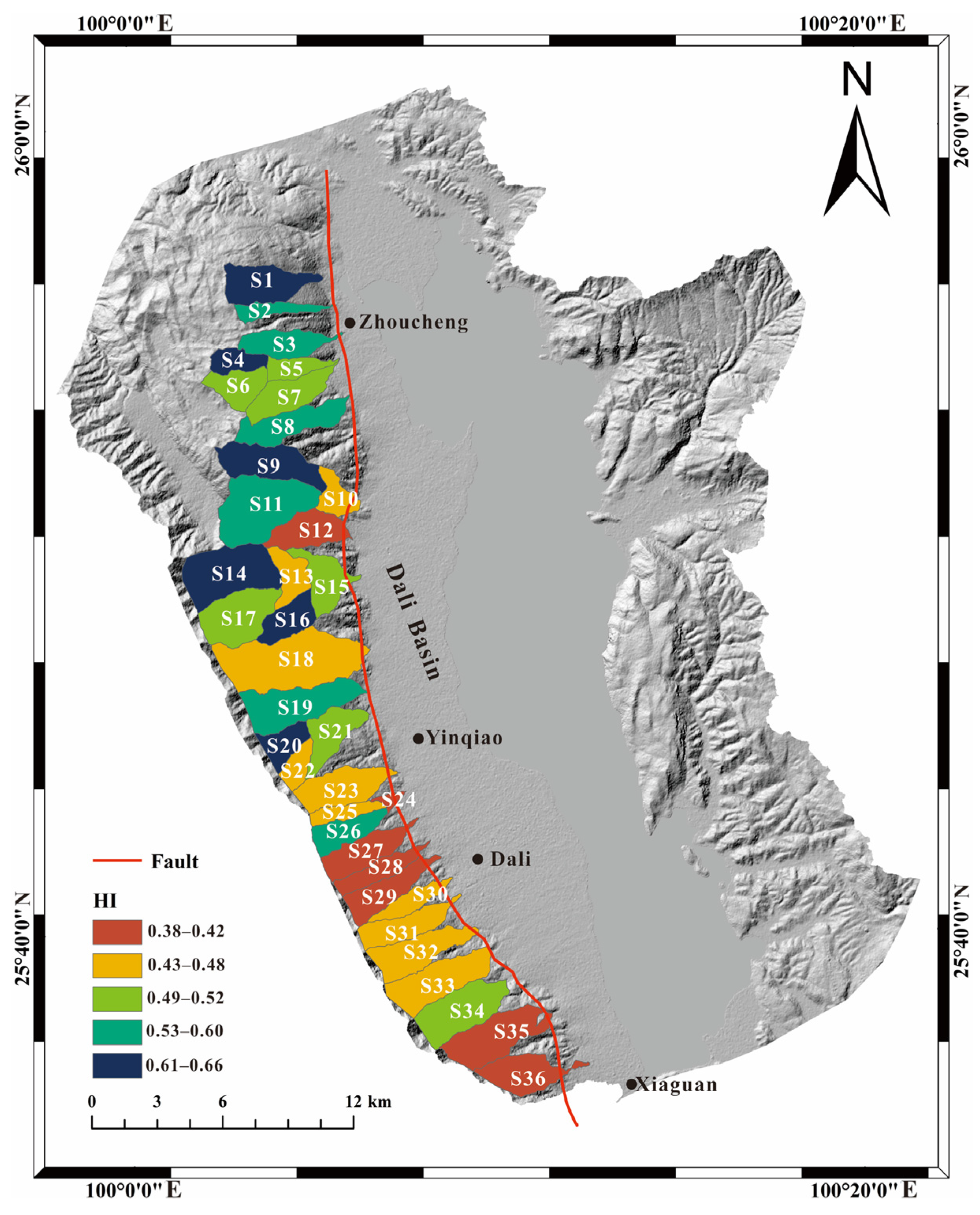
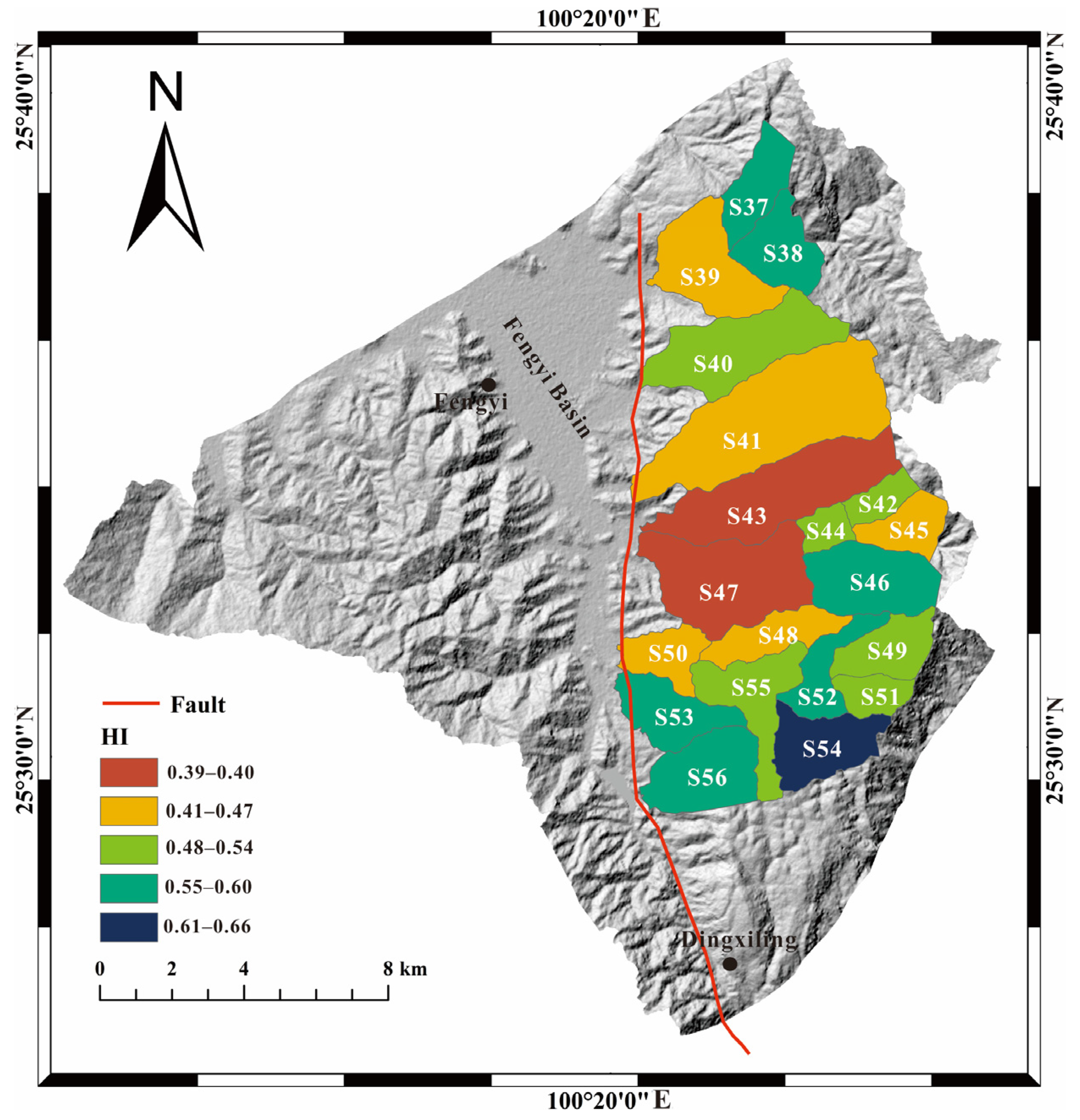
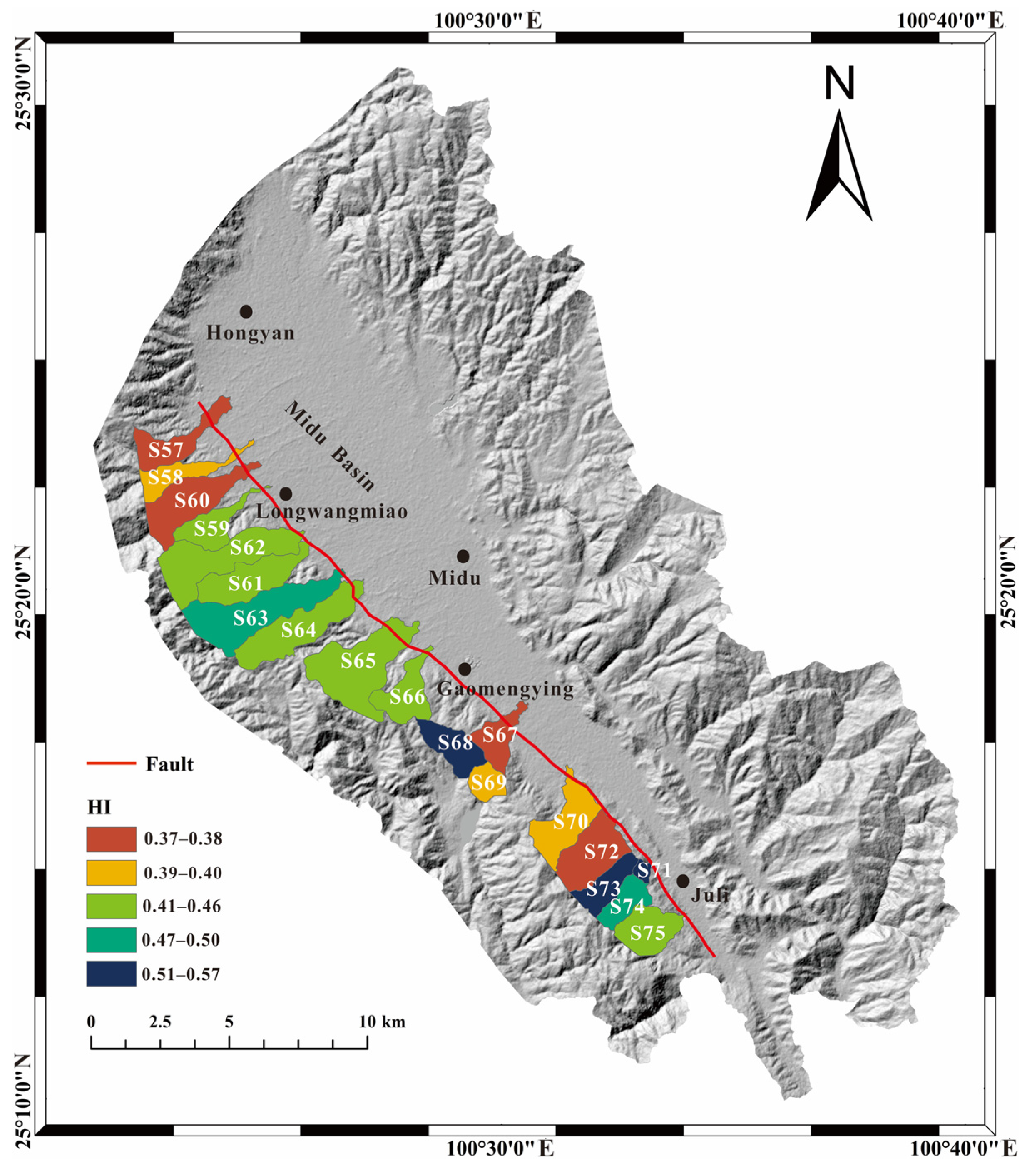
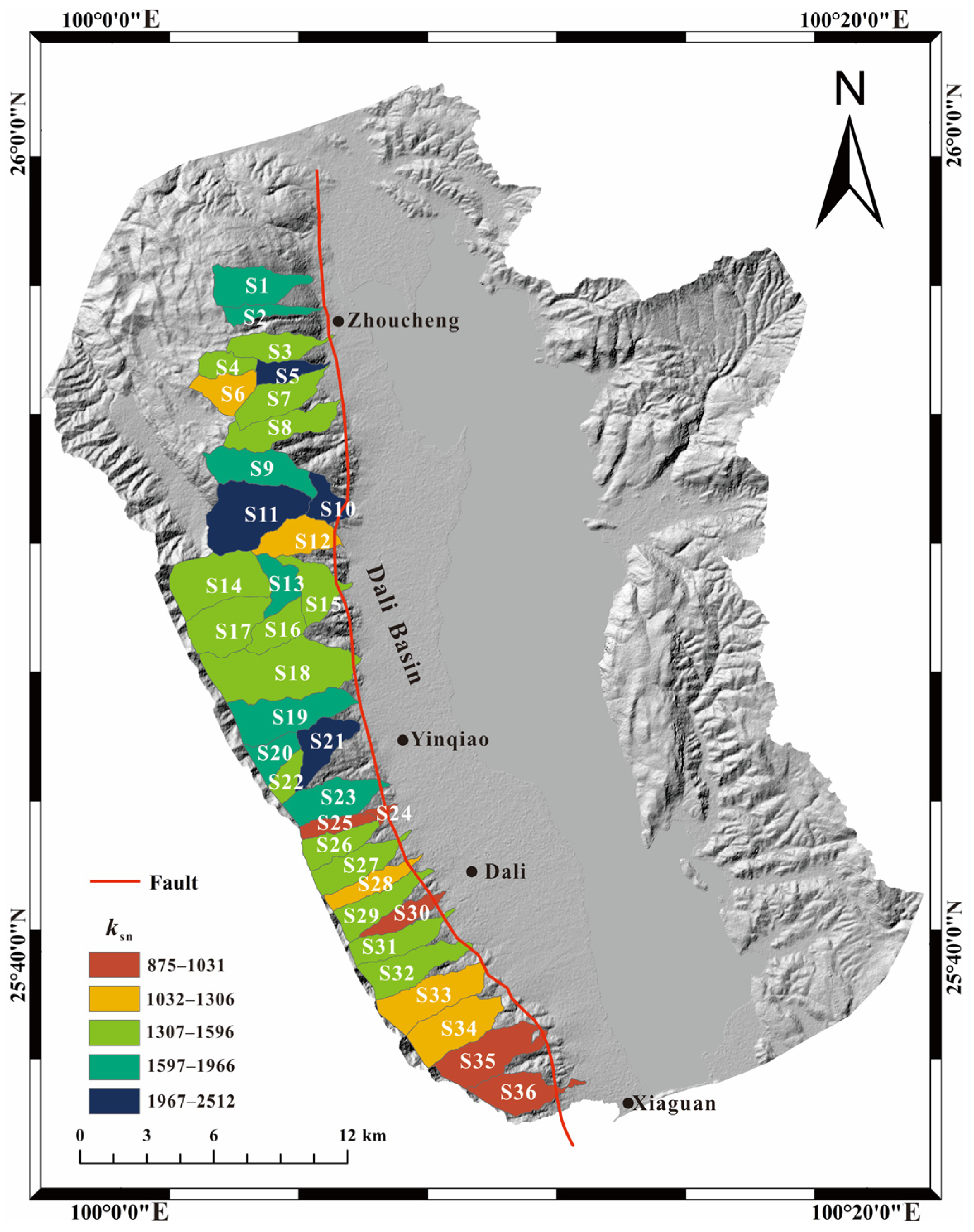

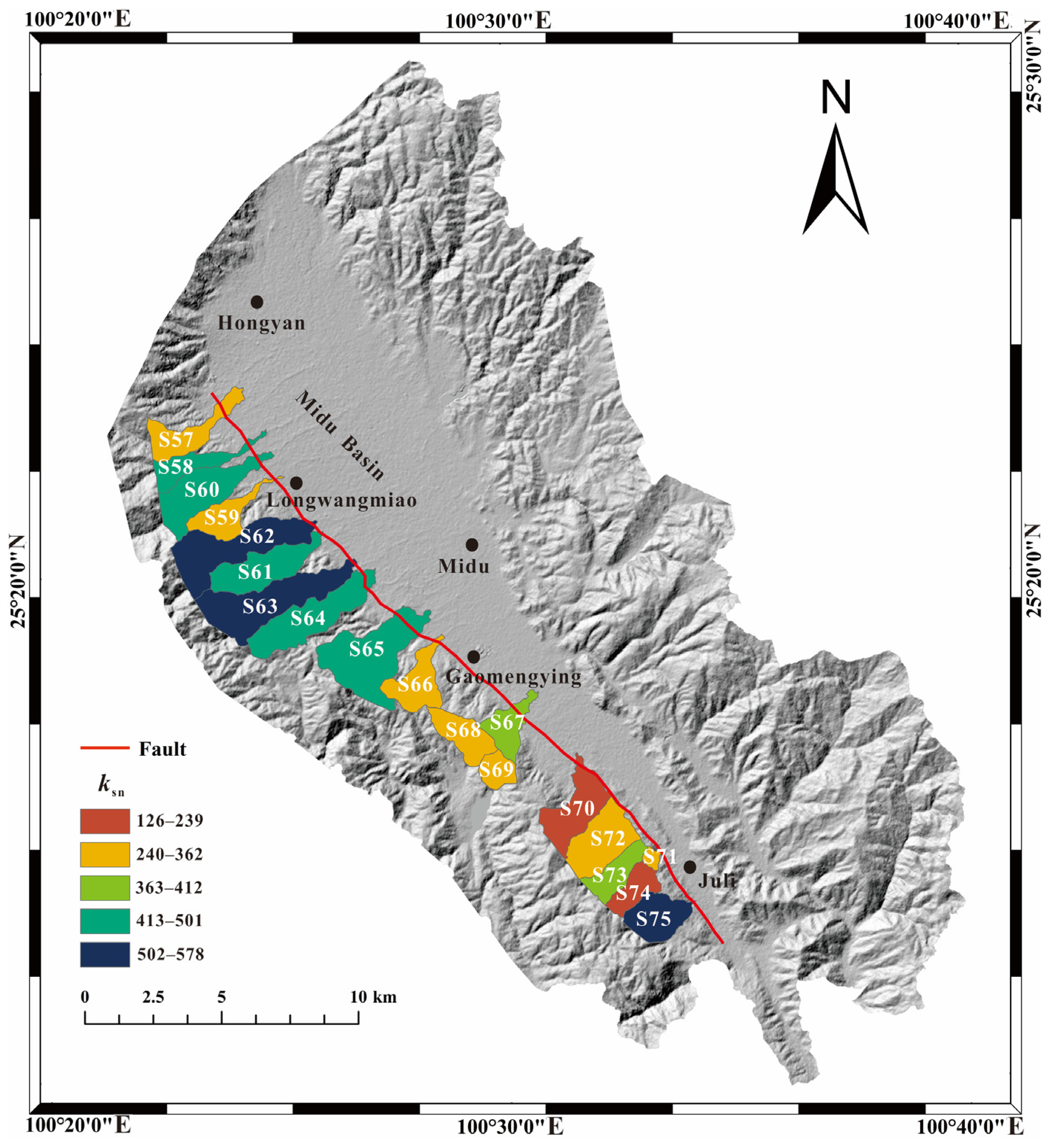
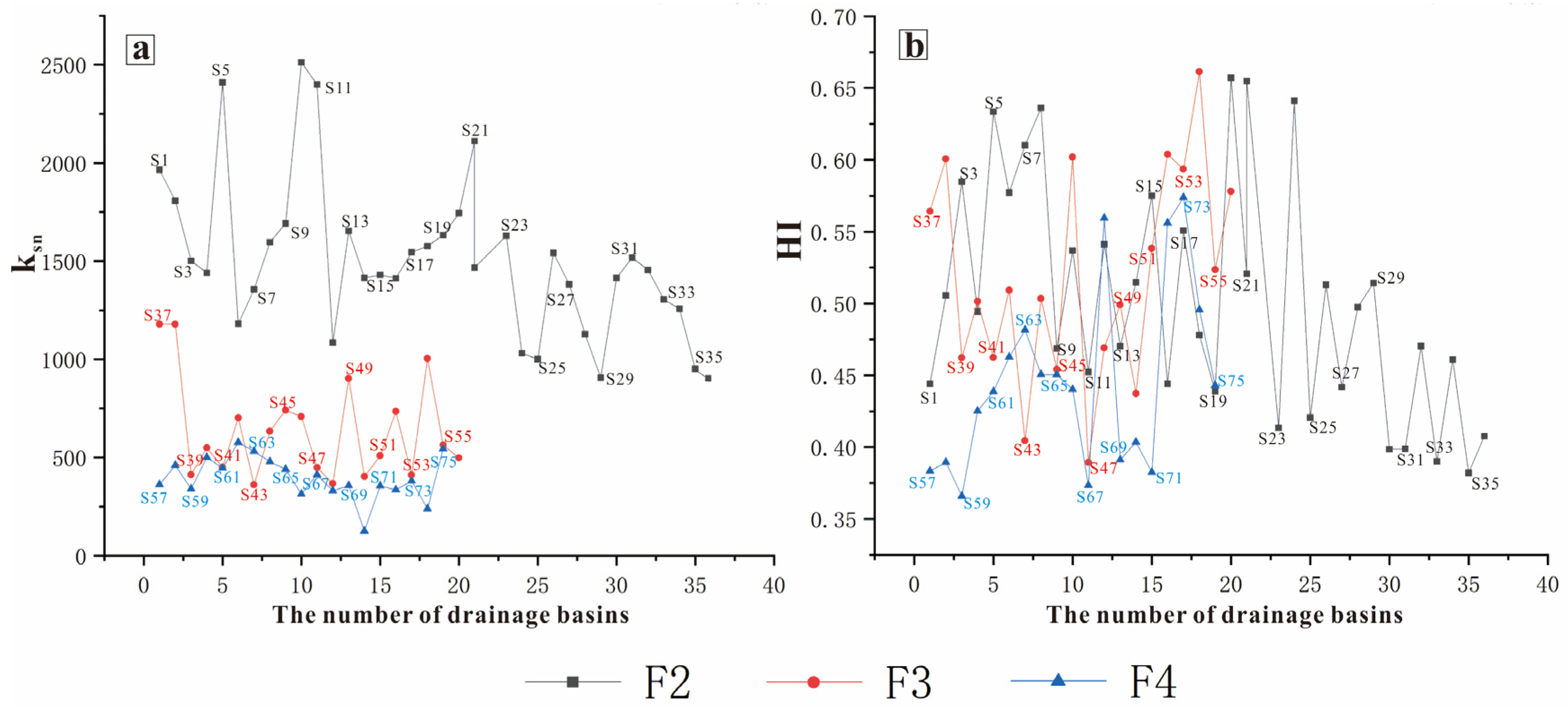
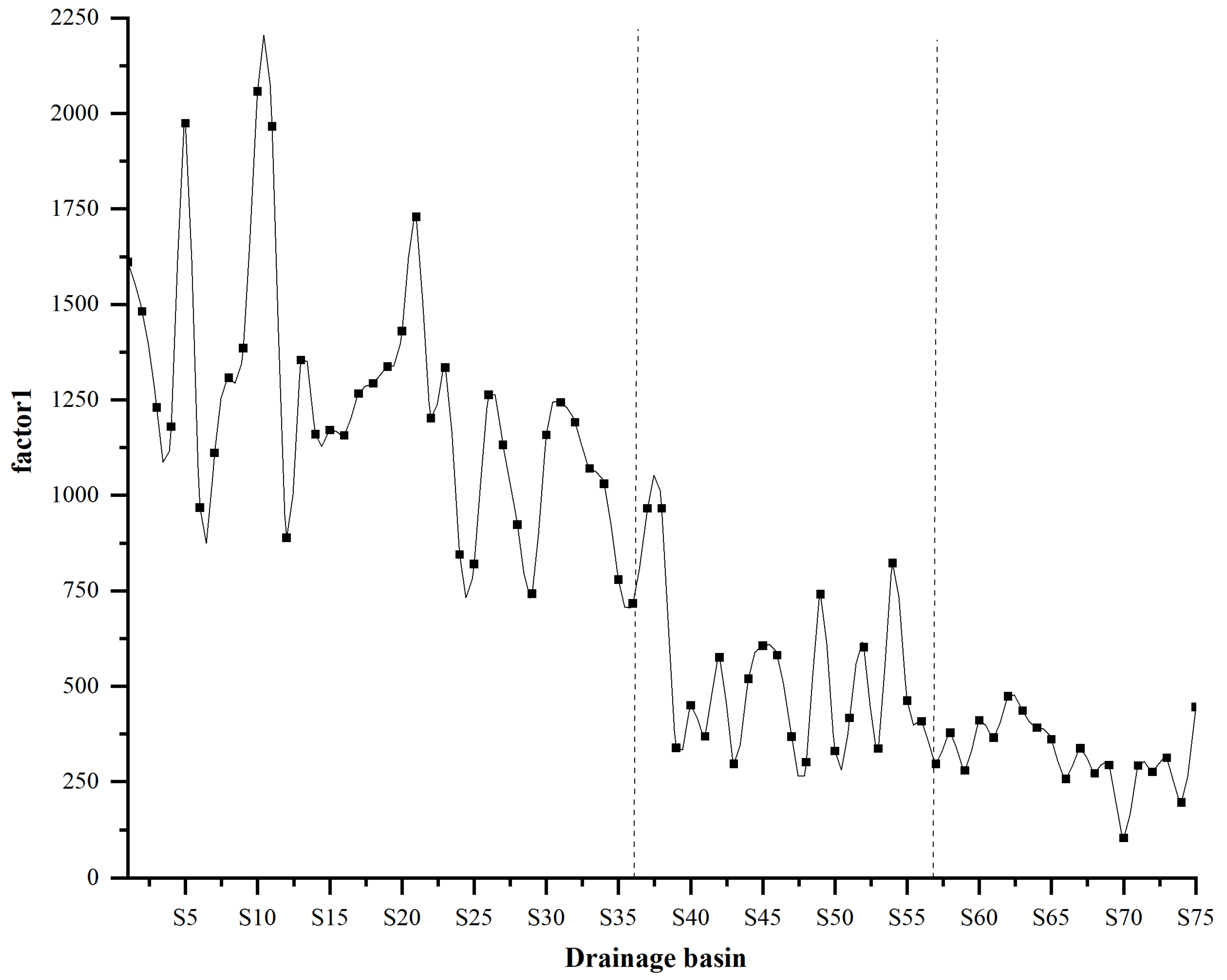



| Drainage Basin | HI | Drainage Basin | HI | Drainage Basin | HI | Drainage Basin | HI | Drainage Basin | HI |
|---|---|---|---|---|---|---|---|---|---|
| S1 | 0.63 | S16 | 0.64 | S31 | 0.44 | S46 | 0.60 | S61 | 0.46 |
| S2 | 0.58 | S17 | 0.51 | S32 | 0.44 | S47 | 0.39 | S62 | 0.44 |
| S3 | 0.55 | S18 | 0.47 | S33 | 0.44 | S48 | 0.47 | S63 | 0.48 |
| S4 | 0.66 | S19 | 0.54 | S34 | 0.50 | S49 | 0.50 | S64 | 0.45 |
| S5 | 0.51 | S20 | 0.61 | S35 | 0.39 | S50 | 0.44 | S65 | 0.45 |
| S6 | 0.51 | S21 | 0.49 | S36 | 0.38 | S51 | 0.54 | S66 | 0.44 |
| S7 | 0.51 | S22 | 0.48 | S37 | 0.56 | S52 | 0.60 | S67 | 0.37 |
| S8 | 0.54 | S23 | 0.45 | S38 | 0.60 | S53 | 0.59 | S68 | 0.56 |
| S9 | 0.64 | S24 | 0.40 | S39 | 0.48 | S54 | 0.66 | S69 | 0.39 |
| S10 | 0.44 | S25 | 0.47 | S40 | 0.50 | S55 | 0.52 | S70 | 0.40 |
| S11 | 0.58 | S26 | 0.58 | S41 | 0.46 | S56 | 0.58 | S71 | 0.56 |
| S12 | 0.41 | S27 | 0.42 | S42 | 0.51 | S57 | 0.38 | S72 | 0.38 |
| S13 | 0.47 | S28 | 0.40 | S43 | 0.40 | S58 | 0.39 | S73 | 0.57 |
| S14 | 0.65 | S29 | 0.46 | S44 | 0.50 | S59 | 0.43 | S74 | 0.50 |
| S15 | 0.52 | S30 | 0.41 | S45 | 0.45 | S60 | 0.37 | S75 | 0.44 |
| Stream | ksn | Stream | ksn | Stream | ksn | Stream | ksn | Stream | ksn |
|---|---|---|---|---|---|---|---|---|---|
| R1 | 1966 | R16 | 1412 | R31 | 1518 | R46 | 709 | R61 | 446 |
| R2 | 1808 | R17 | 1546 | R32 | 1454 | R47 | 449 | R62 | 578 |
| R3 | 1501 | R18 | 1578 | R33 | 1306 | R48 | 367 | R63 | 532 |
| R4 | 1440 | R19 | 1632 | R34 | 1257 | R49 | 904 | R64 | 478 |
| R5 | 2410 | R20 | 1745 | R35 | 951 | R50 | 403 | R65 | 440 |
| R6 | 1181 | R21 | 2111 | R36 | 875 | R51 | 509 | R66 | 314 |
| R7 | 1356 | R22 | 1467 | R37 | 1179 | R52 | 735 | R67 | 412 |
| R8 | 1596 | R23 | 1629 | R38 | 1179 | R53 | 411 | R68 | 331 |
| R9 | 1691 | R24 | 1031 | R39 | 413 | R54 | 1004 | R69 | 358 |
| R10 | 2512 | R25 | 1001 | R40 | 549 | R55 | 564 | R70 | 126 |
| R11 | 2400 | R26 | 1542 | R41 | 450 | R56 | 498 | R71 | 356 |
| R12 | 1085 | R27 | 1382 | R42 | 702 | R57 | 362 | R72 | 336 |
| R13 | 1653 | R28 | 1127 | R43 | 362 | R58 | 461 | R73 | 381 |
| R14 | 1416 | R29 | 906 | R44 | 634 | R59 | 341 | R74 | 239 |
| R15 | 1429 | R30 | 1414 | R45 | 740 | R60 | 501 | R75 | 544 |
Disclaimer/Publisher’s Note: The statements, opinions and data contained in all publications are solely those of the individual author(s) and contributor(s) and not of MDPI and/or the editor(s). MDPI and/or the editor(s) disclaim responsibility for any injury to people or property resulting from any ideas, methods, instructions or products referred to in the content. |
© 2023 by the authors. Licensee MDPI, Basel, Switzerland. This article is an open access article distributed under the terms and conditions of the Creative Commons Attribution (CC BY) license (https://creativecommons.org/licenses/by/4.0/).
Share and Cite
Guo, L.; He, Z.; Li, L. Responses of Stream Geomorphic Indices to Piedmont Fault Activity in the Northern Segment of the Red River Fault Zone. Remote Sens. 2023, 15, 988. https://doi.org/10.3390/rs15040988
Guo L, He Z, Li L. Responses of Stream Geomorphic Indices to Piedmont Fault Activity in the Northern Segment of the Red River Fault Zone. Remote Sensing. 2023; 15(4):988. https://doi.org/10.3390/rs15040988
Chicago/Turabian StyleGuo, Long, Zhongtai He, and Linlin Li. 2023. "Responses of Stream Geomorphic Indices to Piedmont Fault Activity in the Northern Segment of the Red River Fault Zone" Remote Sensing 15, no. 4: 988. https://doi.org/10.3390/rs15040988





